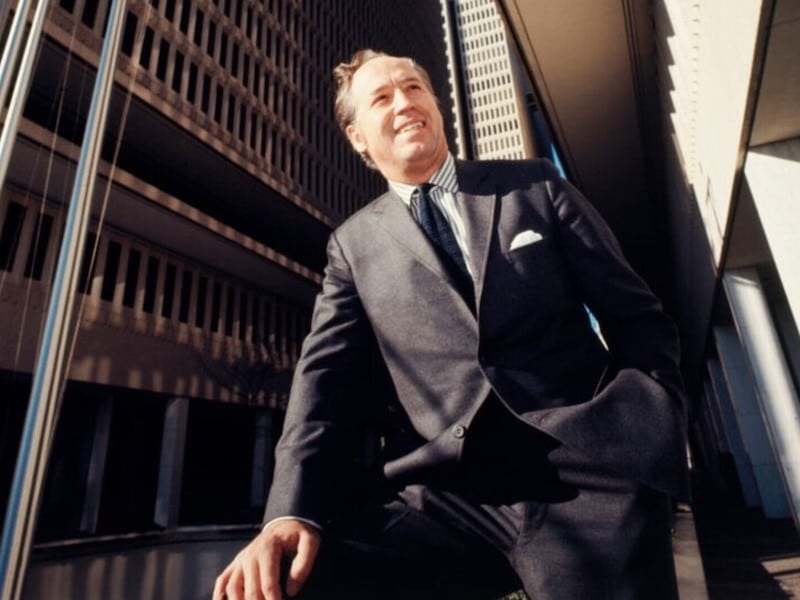A New Design for Detroit
The design for the planned Cadillac Centre downtown will challenge what you think a “Detroit building” looks like. Architect Anthony Caradonna shares his vision.
When architect Anthony Caradonna characterized his design as “subtle” to a group of journalists last week, the room erupted in nervous giggles.
Most Detroiters would define the nonlinear design for the planned Cadillac Centre, a $150 million mixed-use development to join the Monroe block near Campus Martius Park, as anything but subtle.
Caradonna sat down with Model D last week to talk about his vision for the massive downtown project. He explained that he approached the design not as a sculptural curvi-linear entity but rather as “organic and responsive to the people who use it.”
Meaning its form indeed follows its function – believe it or not.
Who is he?
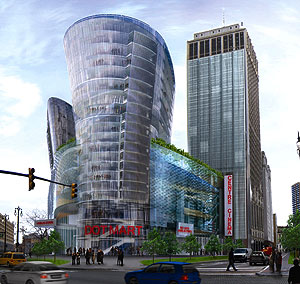 Caradonna’s pedigree speaks volumes. His firm, OPUS Architecture and Design (formerly AC/2 Studio Inc.), is based in New York City and Rome. He and partner Anita Cooney received an honorable mention from ID Magazine in 2000, and Caradonna earned a medal of merit from the American Institute of Architects in 1986.
Caradonna’s pedigree speaks volumes. His firm, OPUS Architecture and Design (formerly AC/2 Studio Inc.), is based in New York City and Rome. He and partner Anita Cooney received an honorable mention from ID Magazine in 2000, and Caradonna earned a medal of merit from the American Institute of Architects in 1986.
He holds degrees from Harvard University and Pratt Institute School of Architecture, where he is now an associate professor and previously directed the undergraduate architecture program. Caradonna has also taught at Parsons School of Design, Cornell University, Columbia University and the University of Oklahoma.
OPUS specializes in many areas of design, including architecture, interiors, lighting, furniture, textile and objects. This Renaissance approach parallels the interdisciplinary course Caradonna teaches each summer in Florence that delves into Italian art, design and architecture.
Approach to design
Caradonna says the impetus for Cadillac Centre came from his first walking tour of Detroit, just over a year ago. Two elements in particular inspired his concept: the city’s “urban spaces” and the soaring atriums that are an integral part of many of its buildings.
By urban spaces, Caradonna is referring to public spaces, like Campus Martius, but he also means spaces between buildings. He says that in Detroit – similar to Toronto and Vancouver — there are spaces between towers that provide framing views of the city, as opposed to Manhattan, where buildings sit much closer together.
He views atriums as another kind of public space, and one that is exceedingly valuable. “There are very few in Manhattan,” he says. “Weather and walking distance have to be considered in Detroit.” The result being open interior gathering spaces that reach their peak, metaphorically speaking, in the Guardian Building – although Compuware’s more-contemporary take informed his thought process as well.
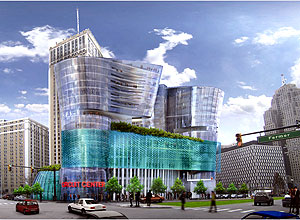 The Cadillac Centre incorporates two glass and steel residential towers bridged by a 12-story retail and entertainment base building. Caradonna says that this base is intended to provide a “continuous frame” around Campus Martius and that the complex itself will complete the park’s “complete ensemble of buildings.”
The Cadillac Centre incorporates two glass and steel residential towers bridged by a 12-story retail and entertainment base building. Caradonna says that this base is intended to provide a “continuous frame” around Campus Martius and that the complex itself will complete the park’s “complete ensemble of buildings.”
The roof garden, atrium and park with water features are all designed to be extensions of Campus Martius’ town square function by welcoming the public and bringing the outdoors in – and vice versa.
The curvature of the structure is in direct response to “the curve of Campus Martius,” says Caradonna. While clearly non-traditional, he insists the design is in no way avant garde. “I’ve tried to work with the elements of Detroit,” he says. “The design is evocative of the magnificent cars that have come from here – I’ve taken inspiration from [them], but tried to make it fresh.”
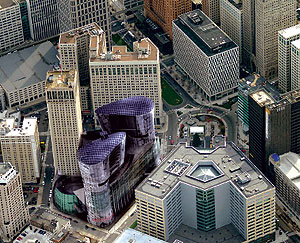 Caradonna is cognizant that he is introducing a certain genre of contemporary architecture to a town that might find it strange or even ugly, and is keen to appear respectful to the city’s historic architecture. “I’ve tried to bring it to Detroit not in an alien way,” he says. “My challenge was how to bridge the old and the new, the future.”
Caradonna is cognizant that he is introducing a certain genre of contemporary architecture to a town that might find it strange or even ugly, and is keen to appear respectful to the city’s historic architecture. “I’ve tried to bring it to Detroit not in an alien way,” he says. “My challenge was how to bridge the old and the new, the future.”
Sustainable aspects
Caradonna was involved with founding, and continues to take part in, Sustainable Pratt, an interdisciplinary group focused on creating curriculum and developing practices that are ecologically responsible at the school.
This commitment to environmental consciousness is apparent in the design for Cadillac Centre, which will be designed with the intention of LEED certification. The building’s roof will be living so as to collect and filter rain water and help control energy consumption.
Additionally, the building will incorporate two types of solar technologies. Thin-skin solar panels will be used on the roof, and solar fibers will be part of the exterior glass walls.
Caradonna is excited about the fibers, a new technology being developed at the University of California-Berkley. Most solar technology must be manufactured in a sterile environment, but these fibers, which can be painted onto virtually any surface, are characterized as “dirty technology,” meaning they are much less expensive to produce.
Impact on local scene
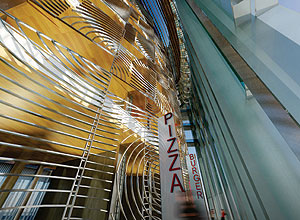 After the Frank Geary-designed Guggenheim Museum helped to transform Bilbao, Spain, from an industrial port town to a tourist destination, “starchitecture” has become an economic development strategy for some cities. Detroit has resisted this trend for some years, although Cadillac Centre could add it to the list that already includes Midwestern counterparts Milwaukee (Santiago Calatrava), Akron (Coop Himmelb(l)au) and Cincinnati (Zaha Hadid).
After the Frank Geary-designed Guggenheim Museum helped to transform Bilbao, Spain, from an industrial port town to a tourist destination, “starchitecture” has become an economic development strategy for some cities. Detroit has resisted this trend for some years, although Cadillac Centre could add it to the list that already includes Midwestern counterparts Milwaukee (Santiago Calatrava), Akron (Coop Himmelb(l)au) and Cincinnati (Zaha Hadid).
While skeptics might claim that this type of architecture will age poorly, resists integration with its city or is not user-friendly, the fact remains that exciting design has the power to, well, excite.
Local architect Brian Hurttienne of Hamilton Anderson Associates thinks so. “Detroit should welcome the design style of Cadillac Centre to push the envelope for design in this city,” he says. “While the design itself needs definition and refinement, it signifies that safe and boxy architecture doesn’t always assure that a project will work. “
Hurtienne also posits that the design can help the developer, the Northern Group, ultimately fill the building with tenants — and he hopes that lesson rubs off around town. “Detroit developers should take note that good design, and somewhat dramatic design, sells.”
Mayor Kwame Kilpatrick says his initial discomfort with the design evolved into distinct admiration. He says Cardonna’s “forward-thinking” design “defies the traditional notions of what a building looks like in Detroit.”
Alex Dembitzer, the CEO of the Northern Group, sums up his company’s ambitious goal like this: “Yes, we want to create an international buzz from this design. But, on a less esoteric and artistic basis, we want to provide services to the neighborhood and revive the community. As it does, we can do it artistically, stylishly and sustainably.”
A worthy goal to be sure — and perhaps even a turning point for development in Detroit.
Kelli B. Kavanaugh is development news editor for Model D.
Cadillac Centre renderings courtesy of Northern Group.
